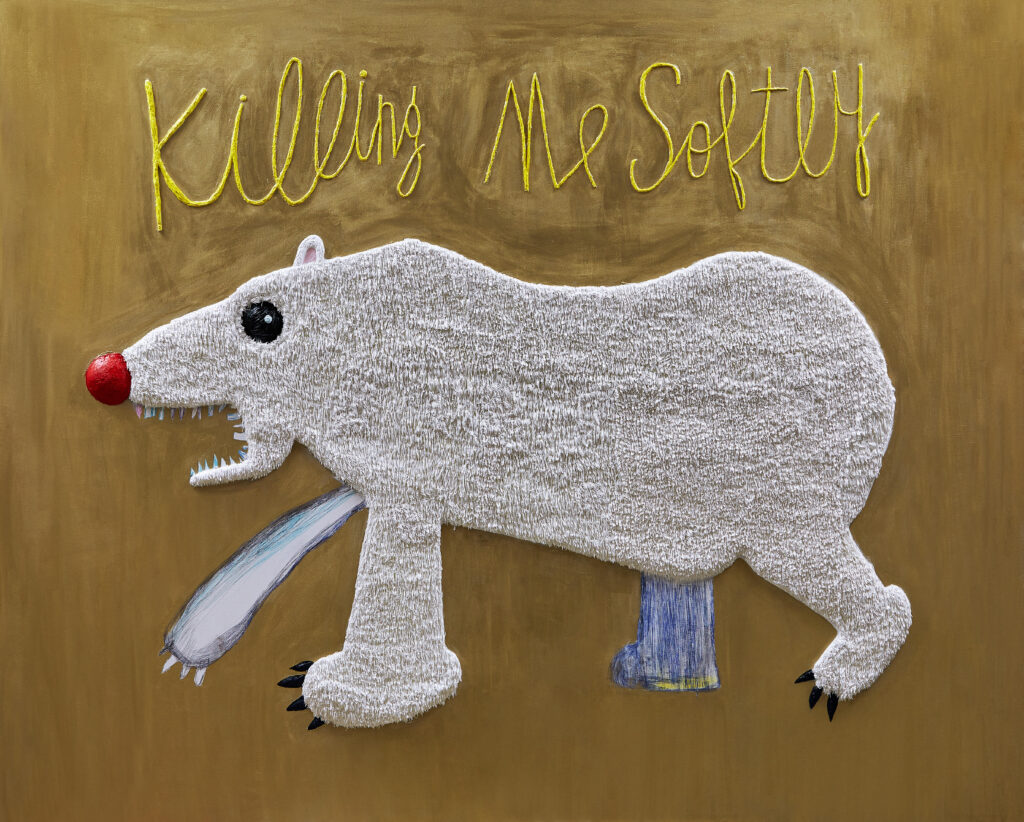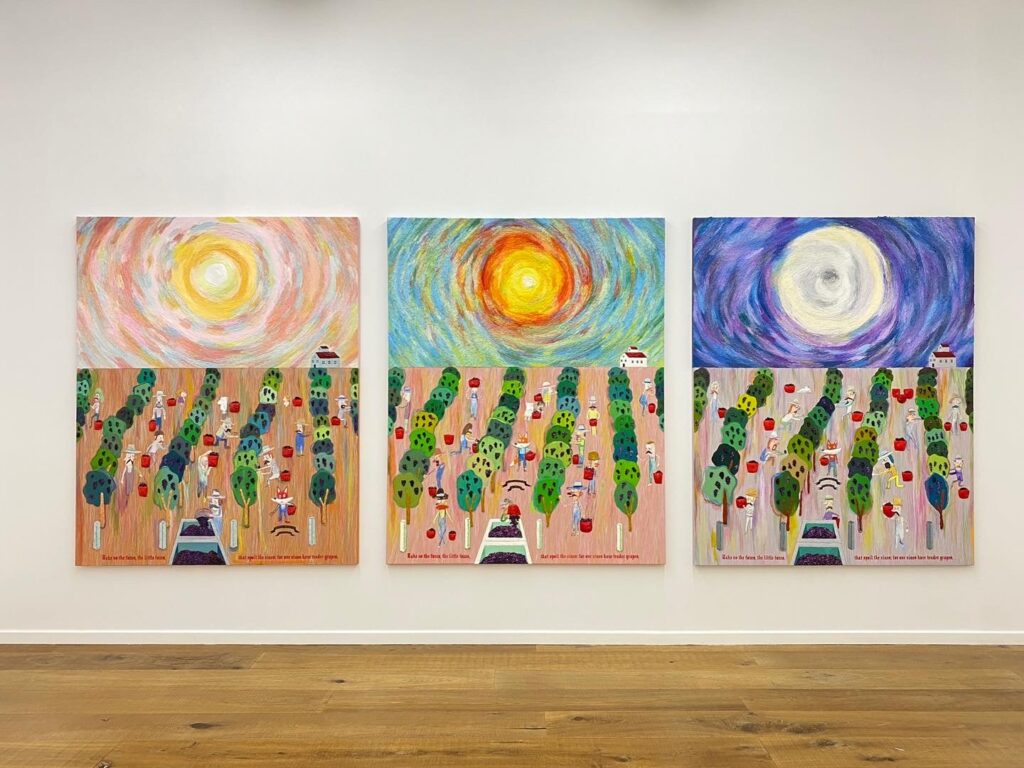November 1 – December 10, 2022

Woo Kukwon est né à Séoul en 1976, il y vit et y travaille. Il est l’un des artistes les plus en vus en Corée actuellement.
Son travail est très reconnaissable. Les couleurs, les textures, les personnages enfantins et les citations sont les caractéristiques les plus distinctives de son œuvre.
Nous sommes très heureux d’organiser sa première exposition en Europe, ici à Paris.
Cette exposition s’articule autour d’un thème très présent dans le travail de Woo Kukwon mais peut-être peu perceptible au premier regard : le désespoir et l’espoir. Tout a commencé par
L’œuvre Killing me Softly illustre tout cette thématique. On y voit un ours polaire, un brin perdu sur le fond or. Référence aussi à la crise climatique, l’animal semble à bout de souffle. La citation est extraite d’une chanson célèbre reprise à plusieurs reprises, c’est le récit d’une femme qui écoute un homme chanter, les paroles sont comme autant de vérités pour elle, ses émotions, ses douleurs, sa tristesse, et cela la tue mots après mots, la laissant dans un profond désespoir.
Tout comme Four Saints Into the Sea, dont la citation est extraite d’une chanson célèbre du groupe The Killers, qui aborde le désespoir d’un homme épris d’une femme ne l’aimant pas en retour, vivant intérieurement un enfer émotionnel, mais restant optimiste malgré tout : « destiny iscalling me
Les toiles intitulées Little Fox continuent sur ce thème. On y voit occupés dans les vignes, des hommes en train de récolter les grappes sous un ciel étrange, tandis qu’un renard s’invite et cueille
Dans le texte du philosophe Kierkegard il y a toutefois une raison d’espérer car il trouve un remède en la foi. C’est l’objet des trois prochaines toiles
Taurus Mountains, Waterfall
Waterfall le psaume 42 :7 « un flot appelle un autre flot au bruit de tes ondées ; toutes tes vagues et tous tes flots passent sur moi » retraçant les combats qui peuvent se livrer au sein de chaque conscience entre l’espoir et le désespoir.
Taurus Mountains raconte le premier voyage missionnaire de l’apôtre Paul vers Antioche pour annoncer la Bonne Nouvelle qui se répandra à travers l’empire romain.
Enfin pour Sprinckle Clean Water, la citation est extraite d’Ezechiel 36 :25 : « je répandrai sur vous une eau pure, afin que vous deveniez purs, je vous purifierai de toutes vos souillures et de toutes vos idoles ». L’eau pure est un emblème de la rupture avec le mal.
Et quelle plus belle preuve d’espérance que d’accueillir au monde un enfant, la série Let Them Eat Cake fête la naissance malgré les difficultés dans ce monde compliqué.
Woo Kukwon was born in Seoul in 1976, and now lives and works in Seoul. He is one of the most popular artists in Korea today. His work is very recognizable. The colors, textures, childish characters, and the added quote are the most distinctive features of his work. We are very delighted to organize his first exhibition in Europe, here in Paris.
It all starts with a reading, « The Sickness Unto Death » by Sören Kierkegard, a 19th century Danish philosopher. This plunges Woo Kukwon into deep thought. In this text, the writer develops his theory on the origin of despair, a consubstantial and inevitable condition for men. Despair is described there as the illness of humanity, an illness of the spirit, “this evil of the self: eternally dying, dying without yet dying, dying death”.
Killing me softly illustrates all this desperation. We see a polar bear, a bit lost on the gold background. Referring to the climate crisis we are currently facing, the animal seems desperate. This quote is taken from a famous song repeated several times, it is the story of a woman who listens to a man sing and who has the feeling of being pierced up to date, her and her despair.
Just like Four Saints Into the Sea, whose quote is taken from a famous song by The Killers, which addresses the despair of a man in love with a woman not loving him back, living an emotional hell inside, but who remains optimistic despite everything: “destiny is calling me”. We see a character with a wrathful expression, Virupaksha (Gwangmok Cheonwang in Korean), “The all-seeing one”, one of the four celestial kings of Buddhism, these hold the demons in check, on a concrete gray background, in front of a greenish expanse, the sea? In the title, there is also a reference in connection with the religion, these four Saints, would it be the Four crowned Saints of Sirmium, Roman stonemasons who, for having refused to execute an idol statue for the emperor, were martyred in leaden coffins and thrown into the sea?
The three paintings entitled Little Fox extend the artist’s thought. We see busy in the vines, men harvesting the grapes under a strange sky, while a fox invites himself and picks a few grapes. This illustrates the quote from the Bible, Song of Solomon 2:15, “ Take us the foxes, the little foxes, that spoil the vines, for our vines have tender grapes”. It is not the big ones, but the little foxes that ravage the vines, all the little things accumulated lead to big consequences, the devil is cunning. And that’s how despair creeps in, one event after another, without us realizing it. The three paintings represent different times of the day, we can see an image of time passing by.
But then is there a remedy? Perhaps, it is in any case the thought of the philosopher Kierkegaard and it is the object of the next three paintings. Taurus Mountains, Waterfall and Sprinkle Clean Water each reproduce a print by Hokusai with the singular characters of Woo Kukwon. Each painting illustrates a quote from the Bible. Waterfall, Psalm 42:7 “ Deep calls to deep at the sound of your waterfalls : all your breakers and your waves have rolled over me ” retracing the battles that can be waged within each conscience between faith and discouragement. Taurus Mountains recounts the Apostle Paul’s first missionary journey to Antioch to announce the Good News that will spread throughout the Roman Empire. Finally Sprinkle Clean Water, the quote is taken from Ezekiel 36:25: ” Then will I sprinkle clean water upon you and ye shall be clean : from all your filthiness, and from all your idols, will I cleanse you “. Pure water is an emblem of breaking away from evil. Because ultimately according to the philosopher, who was a Christian, the remedy for this despair is faith because if death is not the end of everything then there is reason to hope.
And what better proof of hope than to welcome a child into the world, the Let Them Eat Cake series celebrates the birth despite the difficulties, the fights (revolver), and thanks to faith (Bible).
1976년 서울에서 태어난 우국원 작가는 현재 서울에서 거주하며 작업하고 있다. 그는 오늘날 한국에서 가장 사랑 받는 작가 중 한 명이다. 그의 작품을 단번에 알아채는건 그리 어려운 일이 아니다. 독특한 색상과, 질감, 아이같은 등장 인물, 그리고 인용문 등은 그의 작품에서 가장 두드러지는 특징이다. 우리는 여기, 파리에서 그의 첫 유럽 개인전을 열게 되어 매우 기쁜 마음이다.
모든 것은 19세기 덴마크 철학자 쇠렌 키엘르케고르의 « 죽음에 이르는 병»을 읽는 것으로부터 시작된다. 이에 우국원은 깊은 생각에 잠긴다. 이 책에서 저자는 인간의 본질적이고 불가피한 조건인 절망의 기원에 대한 이론을 발전시킨다. 절망은 인간의 질병, 영혼의 질병, “이 자아의 악: 영원히 죽고, 아직 죽지 않고 죽어가는 죽음”으로 묘사된다.
Killing Me Softly는 이 모든 절망을 보여준다. 작품 속 금색 배경에는 어딘가 모르게 길을 잃은 듯한 북극곰이 있다. 우리가 현재 직면하고 있는 기후 위기를 떠올려보면, 이 동물은 절망적인 상태인 것처럼 보인다. 그림의 인용문은 오랫동안 불러진 명곡에서 따온 것으로, 한 남자의 노래를 들으면서 현재 자신의 모습을 꿰뚫고 있다는 느낌을 받는 여자, 그녀와 그녀의 절망에 대한 이야기이다.
Four Saints Into the Sea는 킬러스의 유명한 노래에서 인용한 것으로, 사랑에 빠진 한 남자가 그를 사랑하지 않는 여자를 보며 감정적으로는 지옥을 경험하고 있지만 그럼에도 불구하고 여전히 낙관적이며 “운명이 나를 이끈다”라는 태도로 살아간다. 우리는 콘크리트 회색 배경에 도깨비와 같은 형상을 한, 불교 사대천왕 중 한 명인 “모든 것을 보는 자”인 비루팍샤(광목천왕)라는 분노한 표정의 인물을 발견한다. 푸른 창공과 바다를 뜻하는 것일까? 제목에는 네 명의 종교적 성인을 언급하는데, 로마 석공인 시르미움의 4명의 성인이 황제를 위해 우상을 만드는 것을 거부한 이유로 납으로 된 관에서 순교했다는 이야기가 떠오르기도 한다.
Little Fox라는 제목의 세 그림은 작가의 생각을 확장한다. 이상한 하늘 아래서 포도를 수확하는 사람들 사이에서, 여우가 즐겁게 몇 개의 포도알을 따서 먹고있다. 이것은 성경 솔로몬의 아가서 2장 15절에 대한 언급이다. 포도나무 덩굴이 황폐화되는건 모든 작은 것들이 쌓여가면서 돌이킬 수 없는 시점에 이르렀을 때의 결과이다. 악마는 그만큼 교활하다. 그리고 그러한 존재는 우리가 깨닫지 못하는 사이에 모든 일들에 차례대로 스며든다. 이 세 개의 그림은 각각의 다른 시간대를 나타내며, 따라서 우리는 시각화된 시간의 흐름을 느낄 수 있다.
그렇다면, 이렇게 힘든 삶에 대한 대책이 있는가? 아마도 그것은 철학자 키엘르케고르의 제안이자 다음 세 작품의 주제이기도 하다. Taurus Mountains, Waterfall, Sprinkle Clean Water는 각각 호쿠사이의 산수화를 재현한다. 또한 각 그림은 성경의 인용문을 보여준다. 폭포, 시편 42:7 “주의 폭포 소리에 깊은 물이 깊은 곳을 부르니 주의 모든 파수꾼과 물결이 나를 덮었나이다”는 믿음과 낙담 사이를 오가는 마음의 갈등을 떠올리게 한다. Taurus Mountains는 로마 제국 전역에 퍼질 복음을 선포하기 위해 사도 바울이 안디옥으로 첫 번째 선교 여행을 갔던 일을 이야기한다. 마지막으로 Sprinkle Clean Water는 에스겔 36장 25절의 인용문이다. 깨끗한 물, 즉 성수는 악에서 벗어남에 대한 상징이다. 궁극적으로 기독교인 이 철학자에 따르면 절망의 치료제는 믿음이기 때문이다. 죽음이 모든 것의 끝이 아니라면 희망을 꿈꿀 이유가 있기 때문이다.
그리고 새로운 생명을 이 세상에 환영하는 것보다 더 나은 희망이 어디 있겠는가? Let Them Eat Cake 시리즈는 어려움과 싸움(리볼버), 믿음(성경)에도 불구하고 탄생을 축하하며 고통의 끝에는 결국 더 나은 내일이 있다는 것을 보여준다.
 Installation view of <Killing Me Softly>, Photography ⓒ Courtesy of 313 Art Project
Installation view of <Killing Me Softly>, Photography ⓒ Courtesy of 313 Art Project
 Installation view of <Killing Me Softly>, Photography ⓒ Courtesy of 313 Art Project
Installation view of <Killing Me Softly>, Photography ⓒ Courtesy of 313 Art Project
 Installation view of <Killing Me Softly>, Photography ⓒ Courtesy of 313 Art Project
Installation view of <Killing Me Softly>, Photography ⓒ Courtesy of 313 Art Project
 Installation view of <Killing Me Softly>, Photography ⓒ Courtesy of 313 Art Project
Installation view of <Killing Me Softly>, Photography ⓒ Courtesy of 313 Art Project


